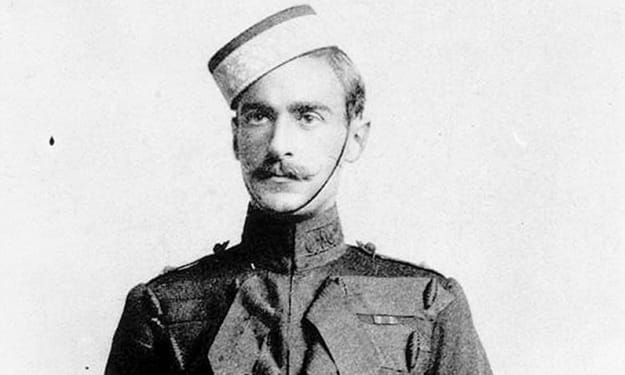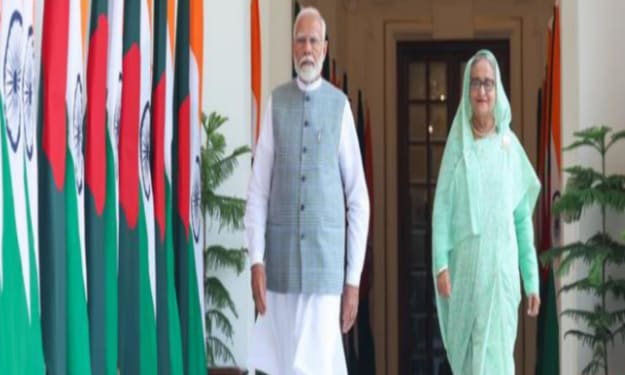Ostpolitik: Germany's Diplomatic Masterstroke
This article tells the story of how Germany was split into two parts and then came back together in the 1900s. The story of Germany's division and subsequent reunification is a complex and compelling narrative that spans the 20th century. After World War II, Germany lost a lot of its land and got divided into East and West. Having suffered significant losses due to German invasions during both World Wars, Soviet leader Joseph Stalin leaned towards the idea of dismantling and partitioning a defeated Germany. His goal was to prevent Germany from regaining its previous strength and posing a renewed threat to European peace and security.

The story of Germany's division and subsequent reunification is a complex and compelling narrative that spans the 20th century. This article will explore the key events that led to the division of Germany, the consequences of this division, and the remarkable reunification process that brought East and West Germany back together as one nation.
Effect of World Wars & Loss of Huge Territorial:
After World War II, Germany experienced huge territorial losses in Europe and beyond, resulting from actions taken by the Allied forces. These changes included the handover of vast eastern territories to Poland and the Soviet Union, including regions such as Silesia, Pomerania, and East Prussia. Additionally, the Free City of Danzig, situated between Poland and the Baltic Sea, became part of Poland.
In total, Germany lost approximately 25% of its pre-war territory, impacting millions of people who were often subjected to forced migration and suffered significant adversities.
These territorial changes had profound geopolitical consequences, contributing to the division of Germany into East and West and fundamentally reshaping the post-war European map.

Joseph Stalin's Strategy: Dismantling Defeated Germany for European Peace:
Having suffered significant losses due to German invasions during both World Wars, Soviet leader Joseph Stalin leaned towards the idea of dismantling and partitioning a defeated Germany. His goal was to prevent Germany from regaining its previous strength and posing a renewed threat to European peace and security.
Despite their wartime alliance, the Soviet Union and the United States, along with Great Britain, experienced a rapid escalation of tensions as World War II drew to a close. The leaders of these nations engaged in post-war negotiations at two significant conferences in 1945, one occurring before the official conclusion of the war and another afterward. These conferences played a pivotal role in laying the groundwork for the onset of the Cold War and the division of Europe, particularly in the case of Germany.
The Yalta Conference:
In February 1945, with confidence in the impending Allied victory, a pivotal meeting took place near Yalta, Crimea, involving Soviet leader Joseph Stalin, U.S. President Franklin Roosevelt and British Prime Minister Winston Churchill. This conference aimed to chart the course for the post-World War II reorganization of Europe, with each leader bringing their own vision for rebuilding and restoring order in the war-ravaged continent.
Roosevelt sought Soviet participation in the newly formed United Nations and immediate Soviet support in the ongoing Pacific War against Japan. Churchill advocated passionately for free and fair elections leading to the establishment of democratic regimes in Central and Eastern Europe, particularly in the case of Poland. Stalin, however, had a different perspective; he aimed to establish a "sphere of influence" for the Soviet Union in Central and Eastern Europe, beginning with Poland, as a strategic buffer zone between the Soviet Union and the Western capitalist world. Clearly, there were significant conflicting interests that needed resolution.
After extensive negotiations, the Yalta Conference produced two vital decisions about Germany as follows:
01. Nazi Germany was to surrender unconditionally, and Germany, as well as Berlin, would be divided into four occupation zones controlled by the United States, Great Britain, France, and the Soviet Union.
02. Germany, including both civilians and prisoners of war, would be held accountable for the war through reparations, including forced labor to repair the damage inflicted by the war on their own country and others.
Potsdam Conference (1945):
The Potsdam Conference took place in Potsdam, Germany, spanning from July 17 to August 2, 1945. The leaders of the Allied powers, including Joseph Stalin (Soviet Union), Winston Churchill (later replaced by Clement Attlee, United Kingdom), and Harry S. Truman (United States), gathered to discuss the fate of Germany and its division.
After the Potsdam Conference, Germany experienced a profound partition into four occupied zones, with each zone being administered by one of the Allied powers: France in the southwest, Great Britain in the northwest, the Soviet Union in the east and the United States in the south. The city of Berlin, situated within the Soviet zone, was also subdivided into four occupied zones.

Furthermore, as a result of the Potsdam Conference, Germany lost territory east of the Oder and Neisse rivers, which was placed under Polish control. This territorial shift led to the expulsion of approximately 15 million ethnic Germans from the affected areas, and their forced displacement was marred by terrible conditions. Many suffered from exposure and starvation on overcrowded trains, while others were subjected to forced labor camps under the governance of Poland and Czechoslovakia.
Please CLICK HERE for getting more fascinating Historical News.
Following the conclusion of World War II, the aftermath saw the emergence of two distinct German states. West Germany, formally recognized as the Federal Republic of Germany, was founded in May 1949. This western portion of Germany aligned itself with the United States, the United Kingdom, and France and adopted a Western capitalist model with a market-oriented economy. Conversely, East Germany, officially named the German Democratic Republic, was established in October 1949. It formed a close alliance with the Soviet Union and adopted highly centralized communist governance.
These differing directions laid the foundation for separate and unique socioeconomic developments in the two German states.
Ideological Differences:
The division of Germany was not just a result of practical post-war occupation; it was also a reflection of the growing ideological differences between the Western Allies and the Soviet Union. The Western Allies embraced democracy and capitalism, while the Soviet Union promoted communism. These conflicting ideologies would shape the future of the two German states.
Establishment of the Federal Republic of Germany (West Germany):
The Federal Republic of Germany was established in the west with the enactment of the Basic Law on 23rd May 1949. The initial Bundestag elections took place on 14th August, 1949. The capital of West Germany was Bonn, and Konrad Adenauer became its first Chancellor. West Germany quickly emerged as a stable and prosperous nation under Western influence.
The German Democratic Republic (East Germany):
In response to the establishment of West Germany, the Soviet-controlled zone in the eastern part of Germany became the German Democratic Republic (East Germany) in 1949. East Germany adopted a socialist system and aligned itself with the Soviet Union. Walter Ulbricht served as the first Secretary-General of the Socialist Unity Party, effectively leading East Germany.
The Berlin Wall (1961):
During the Cold War (1947–1991) in 1961, the German Democratic Republic (East Germany) constructed the Berlin Wall to prevent its citizens from escaping to West Berlin. This concrete barrier, an enduring symbol of the Cold War, stood for nearly three decades, dividing not just ideology but also the city of Berlin itself.
The construction of the Berlin Wall, along with the occupation of East and West Germany, led to economic disparities between the two nations. West Germany benefited from an influx of wealthy foreign soldiers, which boosted its economy, while East Germany, under Soviet authoritarian rule, experienced more challenging economic conditions.
Please CLICK HERE for getting more fascinating Historical News.
The wall stood as a strong reminder of the Cold War and the division of Germany for nearly three decades.
In 1989, a wave of political changes speeded through Eastern Europe, and unrest chaos in Germany, applying intensifying pressure on the East German government to ease its travel restrictions to West Germany. Then, in a pivotal moment, a group of passionate West Berliners jumped onto the Wall, and their actions flashed a powerful response from East German youth.
The night of November 9, 1989, scratched its place in history as the night when the Wall finally crumbled. The world witnessed the Wall coming down, as the divisions of the past gave way to a new era of hope and togetherness.
Effects in Divided Germany:
The division of Germany after World War II had a profound impact on the lives of its citizens in the post-divided era. While those in West Germany experienced economic prosperity and enjoyed political freedoms, their counterparts in East Germany faced economic hardships, personal liberties restrictions, and the watchful eye of a surveillance state.
In the 1950s and 1960s, West Germany experienced rapid industrialization, resulting in improved living standards and economic progress. In stark contrast, East Germany struggled with a centrally planned economy, leading to lower wages and a diminished quality of life.
Under the control of the Stasi (secret police), the East German government closely monitored its citizens, curtailed freedom of expression, and restricted travel outside the Eastern Bloc. Dissent often resulted in severe consequences, including imprisonment. These stark differences between the two German states in the post-divided era profoundly shaped the lives of their respective populations.
The Path to Reunification:
The dream of a reunified Germany remained alive throughout the Cold War, but it was a distant and challenging goal.
Ostpolitik that worked as a Powerful Doctrine:
Ostpolitik, which translates to "Eastern Policy" in English, was a foreign policy approach initiated by West Germany in the late 1960s and early 1970s under the leadership of Chancellor Willy Brandt. The primary goal of Ostpolitik was to improve relations between West Germany and the countries of Eastern Europe, particularly the Soviet Union and East Germany (the German Democratic Republic), in the context of the Cold War. Ostpolitik played a significant role in eventually paving the way for the reunification of Germany in 1990.
Through Ostpolitik, West Germany sought to establish diplomatic relations with Eastern European countries, including the Soviet Union and East Germany. The normalization of relations involved the exchange of ambassadors and diplomatic missions, facilitating communication and dialogue.
Please CLICK HERE for getting more fascinating Historical News.
Ostpolitik encouraged increased people-to-people contacts, such as family visits between East and West Germany, as well as cultural and scientific exchanges. These exchanges fostered a sense of unity among the German people and contributed to the gradual breaking down of the Berlin Wall.
The reunification of East and West Germany in a historic event on October 3, 1990, represented a remarkable and intricate process that effectively concluded the Cold War and united the nation. Here are 15 pivotal elements illustrating this journey:
Treaty on the Final Settlement: In 1990, the signing of the "Treaty on the Final Settlement with Respect to Germany" solidified the complete sovereignty of the reunified Germany and marked the conclusion of the post-war occupation.

Diplomatic negotiations involving both German states and the four occupying powers (the United States, United Kingdom, France, and the Soviet Union) culminated in the "Two-Plus-Four Agreement." This accord provided the foundation for the eventual reunification of Germany.
Official Reunification (October 3, 1990): On October 3, 1990, East and West Germany officially merged to form a single, self-governing nation. This significant moment is now commemorated as German Unity Day.
The unification of Germany signified a monumental achievement, symbolizing the termination of the Cold War era in Europe and the triumph of peaceful diplomacy. It heralded a fresh beginning for the German people, commencing a challenging yet gratifying voyage of reconstruction and integration following 45 years of division.
Conclusion:
The division and reunification of Germany is a remarkable tale of resolve, settlement, and renovation. In the complex story of Germany's reunification, Ostpolitik played as beauty of Diplomacy or Doctrine. Through dialogue, diplomacy, and engagement with Eastern Europe, Ostpolitik turned old divisions into bridges of communication. Today, a united Germany stands as a symbol of hope and a powerful Diplomacy.
Please CLICK HERE for getting more fascinating Historical News.
About the Creator
Mohammed Shahidullah-Bin-Anwar
Mohammed Shahidullah, a Blogger, writes on Historical News. After completing Master's in Bengali from Dhaka University, I accumulated over 15 years of experience in various private companies. Plz visit TIME PRINTER, you will not be upset.
Enjoyed the story? Support the Creator.
Subscribe for free to receive all their stories in your feed. You could also pledge your support or give them a one-off tip, letting them know you appreciate their work.






Comments (1)
Outstanding! Awesome story,